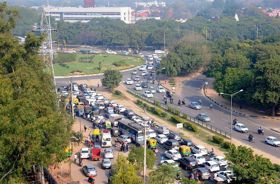Raaja Bhasin
The Himalaya form the spine of Himachal Pradesh and traverses diagonally through what is roughly the middle of the state. When we look north – as most of us do, considering that there are a far lesser number of people in and around the state to look south – the mountains appear as one long unbroken chain.
A few of us realise that the core of the Greater Himalaya is just one part of an immense snow-covered mass of considerable complexity. Sub-systems like the Pir Panjal, the Dhauladhar and the Zanskar intersperse these with the equally lofty heights. Passing through Himachal, this magnificent mountain chain begins from the Nanga Parbat massif in Pakistan and some 2,600 km later, tapers off at the Namche Barwa peak in Myanmar. Along the way, sharp razors of rock, barely softened by snow, rise as if to slash the skies and in their wide, bold swipe of basalt, gneiss and granite, create some of the most dramatic landscapes on Earth.
The process of forming this chain began about 80 million years ago. At that time, the Earth’s land mass consisted of two giant continents – Gondwanaland in the south and Laurasia in the north. A huge chunk of land severed itself from the upper Gondwanaland and swept right across the Sea of Tethys that divided them. Fifty million years later, this giant engine flung itself at the Asian continent. The sea was trapped in a vice-like grip and formed a vast inland lake till the march of the tectonic plates slowly drained the waters over the sides. That piece of land which had moved north has become our country, India. In a subterranean action that knifed upwards, this mountain system gradually came into being. As the heights of the Himalaya rose from the bottom of the sea, often enough, younger rock wormed its way under older layers. The sheer cliff faces near Khab, the confluence of the rivers Sutlej and Spiti, expose the workings of this underground drama quite clearly. Another throwback to those millions of years past, in the Kibber sanctuary, one can find ammonite fossils that were once deep down on a sea bed, now scattered on snow-covered heights.
Legend has it...
Legend does not vary with geological fact. The Indian epics speak of Bhagwan Vishnu, who lived on the edge of a great sea. His only companions were a pair of sea gulls. The female would lay her eggs on the beach, but the tide would creep up and destroy them. The gulls asked Vishnu for help and he drank up the sea. In place of the sea, stood the newly created Earth. As a tired Vishnu slept, the demon Hiranyaksha violated Mother Earth. In agony, her limbs reached out to the sky and became the Himalaya.
Unlike many other mountain systems across the world, like the Andes and the Alps, where wide swaths have been eyed with fear and as the home of trolls and demons, the Himalaya has never had this connotation. These mountains have been treated as the retreat of sages and wise men; they have held the homes of numerous deities of the Hindu pantheon.
Many mountains and the places that rest by their side draw their names from Lord Shiva. In Himachal, among others, the Kinner Kailash, Shrikhand Mahadev and Manimahesh are considered as some of his mythical abodes. Other peaks are homes to other deities; for example, in Trans-Himalayan Lahaul, the Gyephang Goh is considered to be the abode of the area’s patron god — Gyephang. Individual peaks and smaller hills have stories of their own. The Kamru Nag Dhar has a secluded temple and deity Kamru Nag’s anger is regarded to cause unwanted rain and floods. The primary offering to the devta is of ornaments and coins that are cast in the lake that lies by the temple. In its neighbourhood is the hill of Shikari Devi – and similar to the story of Athena, here, she is the goddess of the hunt, who, in an age now gone, was propitiated before a hunting expedition
(The writer is an author, historian and journalist)


























